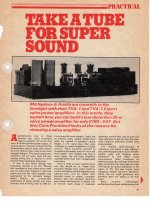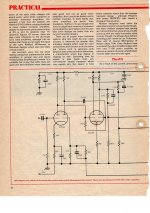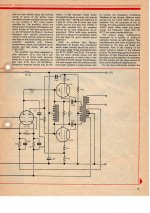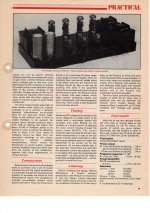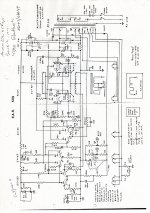I just noticed that Edcor makes some low primary Z single ended OTs:
CXSE25-150
CXSE25-300
CXSE25-600
CXSE25-1.25K
If one were to remove the gap spacer, and use them in P-P Circlotron mode, the use-able magnetic flux would be doubled (+ and - flux use-able now versus just one polarity for SE). That would double the AC winding voltages, which in turn quadruples the Watts rating. (V * V / R = W)
So turning the 25 Watt rated SE xfmrs into 100 Watt Circlotron P-P OTs. The physical size of these xfmrs is the same as their 100 Watt P-P OTs already, so no real surprise. The small residual gap would reduce the primary inductance some from purpose built P-P OTs, but would be way above the SE case. One could use some big clamps and boards to press the I lams down tightly before re-tightening the bolts.
One should check the winding resistances on these to make sure they are similar to P-P versions of 100 Watt rating for the same primary Z. It's possible that the SE design uses more turns of smaller wire to get the primary inductance up with the gap present. Also check the bobbin to see if it is filled fully with wire like a P-P design would be.
With 400V B+ (allowing for 50V tube knee voltages) floating supplies, one could use a 600 Ohm primary OT in Circlotron mode to get 100 Watts output. Approx. 1/2 Amp (+ idle current) peaks would point toward medium (or big) size TV Sweep tubes.
One might request the UL tap at 50% to obtain a ground reference for the driver stage more easily.
So, once again, one can buy an off the shelf OT to make a MAC UC OT equivalent.
Nice to know that Circlotron mode design is easily accessible.
CXSE25-150
CXSE25-300
CXSE25-600
CXSE25-1.25K
If one were to remove the gap spacer, and use them in P-P Circlotron mode, the use-able magnetic flux would be doubled (+ and - flux use-able now versus just one polarity for SE). That would double the AC winding voltages, which in turn quadruples the Watts rating. (V * V / R = W)
So turning the 25 Watt rated SE xfmrs into 100 Watt Circlotron P-P OTs. The physical size of these xfmrs is the same as their 100 Watt P-P OTs already, so no real surprise. The small residual gap would reduce the primary inductance some from purpose built P-P OTs, but would be way above the SE case. One could use some big clamps and boards to press the I lams down tightly before re-tightening the bolts.
One should check the winding resistances on these to make sure they are similar to P-P versions of 100 Watt rating for the same primary Z. It's possible that the SE design uses more turns of smaller wire to get the primary inductance up with the gap present. Also check the bobbin to see if it is filled fully with wire like a P-P design would be.
With 400V B+ (allowing for 50V tube knee voltages) floating supplies, one could use a 600 Ohm primary OT in Circlotron mode to get 100 Watts output. Approx. 1/2 Amp (+ idle current) peaks would point toward medium (or big) size TV Sweep tubes.
One might request the UL tap at 50% to obtain a ground reference for the driver stage more easily.
So, once again, one can buy an off the shelf OT to make a MAC UC OT equivalent.
Nice to know that Circlotron mode design is easily accessible.
Last edited:
Looks like this SE into Circlotron scheme is not going to work well.
I just measured a Hammond 1640SE primary at 83.7 Ohms DC (1250 Ohm AC impedance) and a Hammond 1650T P-P primary at 45 Ohms DC (1900 Ohms AC impedance)
If the wire size were consistent between SE and P-P, the DC Ohms should scale similarly to the AC Ohms. But I find the SE case is 2.82 x higher Ohms than expected. I assume Edcor does something similar. The SE xfmr has 2.8x as much resistance versus the equivalent P-P case to make up for the low primary inductance with the air gap by using many more turns. So converting SE OTs to Circlotron xfmrs will lead to exorbitant resistive losses.
Nice idea, but it fails in reality.
I guess one will just have to special order a 600 Ohm primary Circlotron OT.
A work around might be to use a 300 Ohm SE xfmr as a 600 Ohm P-P Circlotron xfmr, by using the 4 Ohm SE secondary as the 8 Ohm P-P secondary. Would need to check the AC voltages allowed on the windings before saturation sets in, to determine the max power handling capability (at low freq.).
I just measured a Hammond 1640SE primary at 83.7 Ohms DC (1250 Ohm AC impedance) and a Hammond 1650T P-P primary at 45 Ohms DC (1900 Ohms AC impedance)
If the wire size were consistent between SE and P-P, the DC Ohms should scale similarly to the AC Ohms. But I find the SE case is 2.82 x higher Ohms than expected. I assume Edcor does something similar. The SE xfmr has 2.8x as much resistance versus the equivalent P-P case to make up for the low primary inductance with the air gap by using many more turns. So converting SE OTs to Circlotron xfmrs will lead to exorbitant resistive losses.
Nice idea, but it fails in reality.
I guess one will just have to special order a 600 Ohm primary Circlotron OT.
A work around might be to use a 300 Ohm SE xfmr as a 600 Ohm P-P Circlotron xfmr, by using the 4 Ohm SE secondary as the 8 Ohm P-P secondary. Would need to check the AC voltages allowed on the windings before saturation sets in, to determine the max power handling capability (at low freq.).
Last edited:
Arrgh... Only the CXSE25-1.25K has a 4 Ohm secondary available (other models are 8 Ohms only), to make into the 8 Ohm secondary for P-P Circlotron. The resulting 2.5K primary Z would be too high for Circlotron.
Not working again.
Not working again.
Last edited:
Hi Smoking Amp !
In your opinion what will be the optimum autoformer Z for Circlotron OPS configured of 8xPL519 with B+around 450VDC and screen grids around 150VDC , pentode mode biased very close to pure class B1 ?
btw , IMO shortcut to get good Circlotron OPT is to get max. output AC voltage swing around 220-260V~ from amp output and than to use some suitable toroid 240V~ main transformer as OPT .
In your opinion what will be the optimum autoformer Z for Circlotron OPS configured of 8xPL519 with B+around 450VDC and screen grids around 150VDC , pentode mode biased very close to pure class B1 ?
btw , IMO shortcut to get good Circlotron OPT is to get max. output AC voltage swing around 220-260V~ from amp output and than to use some suitable toroid 240V~ main transformer as OPT .
For PL519 with 150V for grid2, the max knee current would be, from the datasheet (15/19)^1.5 = 1.12 Amp per tube. With 4 tubes in each bank, this would allow 4.49 Amps peak. With a knee voltage around 60V, the max delta plate V would be 390V.
So R = V/I = 390/4.49 = 87 Ohms, and Watts out = 1/2 deltaV x Ipk = 875 Watts!!!
This however would exceed the max plate dissipation for the tubes.
For class B, the maximum efficiency is around 70%, so tube loss is 30%.
With 8 x 35 W = 280 W and 70%/30% = 2.33, so max (ideal) class B Watts out would be 2.33 x 280 W = 653 Watts.
If you want the tubes to last very long, then 20% to 30% de-rating is called for.
So safe (ideal) class B Watts out: 0.8 x 653 = 522 Watts
R = deltaV x deltaV / (2 x Wout) = 146 Ohms
Now if this is for audio, class B won't be sounding very good. Class AB will fix the crossover distortion from gm variation. For class AB, efficiency is more like 50% to 60%. So safe class AB Watts out = 280 x 60/40 x 0.8 = 336 Watts out
OK, the MC3500 gets 350 Watts out with 8 6LQ6, for 8 x 30W = 240 Watts of tube diss. So it is running light class aB. Lets take 35/30 x 350 W = 408 Watts out with PL519.
Then R = deltaV x deltaV /(2 x Wout) = 186.4 Ohm for 408 Watts out at B+ of 450 V
186.4 Ohms Circlotron Z primary for 8 x PL519 at 450V B+
So R = V/I = 390/4.49 = 87 Ohms, and Watts out = 1/2 deltaV x Ipk = 875 Watts!!!
This however would exceed the max plate dissipation for the tubes.
For class B, the maximum efficiency is around 70%, so tube loss is 30%.
With 8 x 35 W = 280 W and 70%/30% = 2.33, so max (ideal) class B Watts out would be 2.33 x 280 W = 653 Watts.
If you want the tubes to last very long, then 20% to 30% de-rating is called for.
So safe (ideal) class B Watts out: 0.8 x 653 = 522 Watts
R = deltaV x deltaV / (2 x Wout) = 146 Ohms
Now if this is for audio, class B won't be sounding very good. Class AB will fix the crossover distortion from gm variation. For class AB, efficiency is more like 50% to 60%. So safe class AB Watts out = 280 x 60/40 x 0.8 = 336 Watts out
OK, the MC3500 gets 350 Watts out with 8 6LQ6, for 8 x 30W = 240 Watts of tube diss. So it is running light class aB. Lets take 35/30 x 350 W = 408 Watts out with PL519.
Then R = deltaV x deltaV /(2 x Wout) = 186.4 Ohm for 408 Watts out at B+ of 450 V
186.4 Ohms Circlotron Z primary for 8 x PL519 at 450V B+
Last edited:
note:
I think the MC3500 was running with 475V B+, efficiency will be a little lower at 450V B+ here. The MAC was probably using around 260 Ohm Zpri (one side) (4 x 260 = 1040 Ohm P to P ) [ R = 425V x 425V / (2 x 350W) = 258 Ohm ]
Also, the knee V for PL519 drops to around 50 V at the lower peak current used now. (450V -50V = 400V delta) Screen V can be lowered until peak current can just be reached, that will lower the knee V further and improve efficiency.
So let's see: R = 400V x 400V / (2 x 400W) = 200 Ohms.
So 200 Ohms looks better for Circlotron Zprimary with the 8 x PL519 at 450V B+, and 400 Watt output.
For 350 Watt output at 450V B+: R = 400V x 400V / (2 x 350W) = 228.6 Ohms
I think the MC3500 was running with 475V B+, efficiency will be a little lower at 450V B+ here. The MAC was probably using around 260 Ohm Zpri (one side) (4 x 260 = 1040 Ohm P to P ) [ R = 425V x 425V / (2 x 350W) = 258 Ohm ]
Also, the knee V for PL519 drops to around 50 V at the lower peak current used now. (450V -50V = 400V delta) Screen V can be lowered until peak current can just be reached, that will lower the knee V further and improve efficiency.
So let's see: R = 400V x 400V / (2 x 400W) = 200 Ohms.
So 200 Ohms looks better for Circlotron Zprimary with the 8 x PL519 at 450V B+, and 400 Watt output.
For 350 Watt output at 450V B+: R = 400V x 400V / (2 x 350W) = 228.6 Ohms
Last edited:
Resistive and core loss in the OT will drop power output maybe 5% or so from the above calcs, depending on OT design. The fewer turns in the Circlotron OT will allow using bigger wire than a normal center tapped design, good efficiency.
----------------------------------------------------------------------------------------------------------------------------------------------
Anyone have an Edcor CXSE25 - - OT that they could measure the primary DC Ohms of?
Interested to see if Edcor uses the same amount of over-wind as Hammond did to get the inductance up.
----------------------------------------------------------------------------------------------------------------------------------------------
Anyone have an Edcor CXSE25 - - OT that they could measure the primary DC Ohms of?
Interested to see if Edcor uses the same amount of over-wind as Hammond did to get the inductance up.
Last edited:
Many thanks Smoking-Amp !
now I`m pretty sure that :
- high quality very wide bandwidth OPT or autoformer with Z= 200 or 228,6 Ohms can be build relative easy compared with other types of OPT`s , special when is compared with UC type
- in both cases when max. output power is 400W or 350W and PL519 tubes are biased very lightly in AB class is OK to expect that they will last for decades ,and that output power tubes long life was one of the original design target for MAC amps also .
now I`m pretty sure that :
- high quality very wide bandwidth OPT or autoformer with Z= 200 or 228,6 Ohms can be build relative easy compared with other types of OPT`s , special when is compared with UC type
- in both cases when max. output power is 400W or 350W and PL519 tubes are biased very lightly in AB class is OK to expect that they will last for decades ,and that output power tubes long life was one of the original design target for MAC amps also .
Unity Coupling has even been a subject of DIY, see the attached article that I've found in a British electronics magazine in the late 1970ies. Despite the wording in this article, this »Possum« amplifier apparently has nothing to do with Michaelson & Austin, but was developed by Tim de Paravicini instead. It shares the driver section with his E.A.R. 509 amplifier!
Note the severe drawing flaws in the »Possum« schematics.
Best regards!
Note the severe drawing flaws in the »Possum« schematics.
Best regards!
Attachments
Last edited:
I measured three transformers. My Edcor CXSE's are very old, from when they first started selling to hobbyists and they are painted bright metallic blue from the factory. I don't know if they have changed the recipe since then. The push pull Edcors obviously have more inductance. It takes several seconds for the ohmmeter reading to settle.
Edcor CXSE25-8-5K 83 ohms.
Hammond 1626SEA 169 ohms
Edcor CXPP100-MS-3.3K 153 ohms
Edcor CXSE25-8-5K 83 ohms.
Hammond 1626SEA 169 ohms
Edcor CXPP100-MS-3.3K 153 ohms
I'm going from memory, which is always dangerous, but I'm pretty sure my Hammond 1650R 100W 5K transformer had less than 100 Ohms copper resistance for the primary. I think it was in the high 90s.
Edit: I'll look it up for sure when I get home.
Edit: I'll look it up for sure when I get home.
I just found that Hammond lists the DC Ohms now for the new "A" versions of OTs in the PDF files.
Model - AC - DC
1626SEA 600 15
1640SEA 1250 28
1627SEA 2500 77.5
1630SEA 3500 114
1628SEA 5000 171
1629SEA 6500 197
1638SEA 10000 337
1650TA 1900 46.9 P-P
1650RA 5000 102 P-P
My 1640SE measures 84 Ohms instead of the 28 Ohms listed. This is so far off that I went and checked the AC Volt ratios, but it does measure as a 1250 Ohm AC primary versus the nominal 8 Ohm secondary taps. What the H_ll goes on here? The bobbin appears to be filled to the full window.
George, is there a typo in that Hammond 1626SEA measurement you have? Maybe that's for a 1628SEA?
I just measured the primary inductance on my Hammond 1640SE and I get 18.3 Henries. While the new 1640SEA datasheet says 3.2 Hy. !!!
Looks like the new models are drastically re-designed, with minimal inductance. Even less than Edcor. SQRT (18.3/3.2) = 2.39 x turns. Wire resistance would go up roughly as the square of turns (longer wire and smaller wire) leading to 160 Ohms expected. I guess 84 Ohms measured is good in that perspective. So I can probably use this OT as a 2500 Ohm primary with 8 Ohms load on the 4 Ohm nominal secondary. Need to check DC current rating then, maybe have to re-gap for that.
So it now looks like the Edcor SE OTs could be used as Circlotron OTs.
They don't have all the extra turns that Hammond had on the old SE models I used for calculating.
Need to check the Edcor SE specs now,
Model - AC - DC
1626SEA 600 15
1640SEA 1250 28
1627SEA 2500 77.5
1630SEA 3500 114
1628SEA 5000 171
1629SEA 6500 197
1638SEA 10000 337
1650TA 1900 46.9 P-P
1650RA 5000 102 P-P
My 1640SE measures 84 Ohms instead of the 28 Ohms listed. This is so far off that I went and checked the AC Volt ratios, but it does measure as a 1250 Ohm AC primary versus the nominal 8 Ohm secondary taps. What the H_ll goes on here? The bobbin appears to be filled to the full window.
George, is there a typo in that Hammond 1626SEA measurement you have? Maybe that's for a 1628SEA?
I just measured the primary inductance on my Hammond 1640SE and I get 18.3 Henries. While the new 1640SEA datasheet says 3.2 Hy. !!!
Looks like the new models are drastically re-designed, with minimal inductance. Even less than Edcor. SQRT (18.3/3.2) = 2.39 x turns. Wire resistance would go up roughly as the square of turns (longer wire and smaller wire) leading to 160 Ohms expected. I guess 84 Ohms measured is good in that perspective. So I can probably use this OT as a 2500 Ohm primary with 8 Ohms load on the 4 Ohm nominal secondary. Need to check DC current rating then, maybe have to re-gap for that.
So it now looks like the Edcor SE OTs could be used as Circlotron OTs.
They don't have all the extra turns that Hammond had on the old SE models I used for calculating.
Need to check the Edcor SE specs now,
Last edited:
George, is there a typo in that 1626SEA measurement you have? Maybe that's for a 1628SEA?
Yes, it's a 1628SEA 5K ohms. Sorry, too late to edit the post.
My finger dexterity is getting so bad that I am now a two index finger typist and even so I must proofread everything I type before posting....and I still miss stuff.
Unity Coupling has even been a subject of DIY, see the attached article that I've found in a British electronics magazine in the late 1970ies. Despite the wording in this article, this »Possum« amplifier apparently has nothing to do with Michaelson & Austin, but was developed by Tim de Paravicini instead. It shares the driver section with his E.A.R. 509 amplifier!
Note the severe drawing flaws in the »Possum« schematics.
Best regards!
Thanks for posting those articles/schematics. Pretty cool. I've thought about adding feedback in my UC amp from the feedback winding to the driver cathodes like this.
However, it did make me want to scream a little bit when the author referred to series applied voltage feedback as current feedback. And then he states that the drive required for the output tube grid is 200Vpk-pk, when it is more like 450Vpk-pk. Makes me wonder how much else he got wrong in there.
Inductance that is forced not to work:
If you short the secondary of a transformer, then when you measure DCR of the primary, the Ohmmeter settles faster.
If you short the primary of a transformer, then when you measure DCR of the secondary, the Ohmmeter settles faster.
I am impatient, so I use alligator clips and wire lead to do the shorting, so I can measure faster.
The only inductance slowing down this measurement is the leakage reactance.
If you short the secondary of a transformer, then when you measure DCR of the primary, the Ohmmeter settles faster.
If you short the primary of a transformer, then when you measure DCR of the secondary, the Ohmmeter settles faster.
I am impatient, so I use alligator clips and wire lead to do the shorting, so I can measure faster.
The only inductance slowing down this measurement is the leakage reactance.
Been looking thru the Hammond datasheets, and I'm finding two different primary inductances listed. Apparently the higher L is with a large signal and the lower L is with a 1V level L meter. So the new 1640SEA has 14 Hy and 3.2 Hy listed. My 18.3 Hy measurement was with an L meter. So I went and measured the primary L with a Variac and meters:
30V 3.18mA 25 Hy
60V 5.84mA 27 Hy
120V 12.47mA 25.5 Hy
So I'll call it 27 Hy
The L does peak at some V excitation level.
So this shows SQRT(27/14) = 1.388 x the # of turns versus the old version, assuming the same gap. Both versions are rated at 200 mA DC, so the gap may have changed for a different # of turns. With fewer turns, the gap could shrink for the same current rating, which would increase L some.
One would expect to see the primary winding R to go as 28 Ohm x 27/14 = 56 Ohms (for the same gap), but I measure 84 Ohms for the old 1640SE version.
So the turns on the newer 1640SEA version have been decreased by at least 0.72x (instead of the 1/2.36 = 0.42 ratio I found above) (would be even less than 0.72 ratio if the gap shrunk) So the new 1627SEA (2500 Ohm Z) has about the same # of turns as the old 1640SE (1250 Ohm Z)
So my old 1640SE should work well as a 2500 Ohm Z with 8 Ohm load on the 4 Ohm tap.
---------------------------------------------------------------
George:
that Edcor CXSE25-8-5K, at 83 Ohms measured, looks too low, since the CXPP100-MS-3.3K is 153 Ohms?
30V 3.18mA 25 Hy
60V 5.84mA 27 Hy
120V 12.47mA 25.5 Hy
So I'll call it 27 Hy
The L does peak at some V excitation level.
So this shows SQRT(27/14) = 1.388 x the # of turns versus the old version, assuming the same gap. Both versions are rated at 200 mA DC, so the gap may have changed for a different # of turns. With fewer turns, the gap could shrink for the same current rating, which would increase L some.
One would expect to see the primary winding R to go as 28 Ohm x 27/14 = 56 Ohms (for the same gap), but I measure 84 Ohms for the old 1640SE version.
So the turns on the newer 1640SEA version have been decreased by at least 0.72x (instead of the 1/2.36 = 0.42 ratio I found above) (would be even less than 0.72 ratio if the gap shrunk) So the new 1627SEA (2500 Ohm Z) has about the same # of turns as the old 1640SE (1250 Ohm Z)
So my old 1640SE should work well as a 2500 Ohm Z with 8 Ohm load on the 4 Ohm tap.
---------------------------------------------------------------
George:
that Edcor CXSE25-8-5K, at 83 Ohms measured, looks too low, since the CXPP100-MS-3.3K is 153 Ohms?
Last edited:
My Edcor SE 5k:8 25W transformers have an 85 Ohm primary.
Hammond 1650R (push-pull 100W) was 103 Ohms.
Plitron UC transformer has an 80 Ohm primary (total of both primaries).
Some more data points.
Hammond 1650R (push-pull 100W) was 103 Ohms.
Plitron UC transformer has an 80 Ohm primary (total of both primaries).
Some more data points.
Thanks for the info everyone.
I guess I'll have to email Edcor about their 600 Ohm and 300 Ohm CXSE25-- to see what the DC resistance is, but sounds promising from the 83 - 85 Ohm for the 5000 SE. They probably have to build one of them 1st, however, to get the measurement. Would be nice to have a 600 Ohm and 300 Ohm Zpri OT for Circlotron use. (using with gap removed, can probably just request it built with interlaced laminations. Oh, and with the UL tap at 50% too.)
I guess I'll have to email Edcor about their 600 Ohm and 300 Ohm CXSE25-- to see what the DC resistance is, but sounds promising from the 83 - 85 Ohm for the 5000 SE. They probably have to build one of them 1st, however, to get the measurement. Would be nice to have a 600 Ohm and 300 Ohm Zpri OT for Circlotron use. (using with gap removed, can probably just request it built with interlaced laminations. Oh, and with the UL tap at 50% too.)
Last edited:
- Home
- Amplifiers
- Tubes / Valves
- DIY McIntosh Amp
